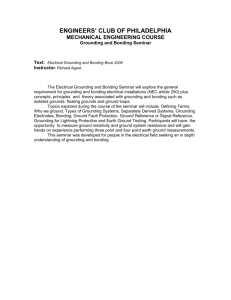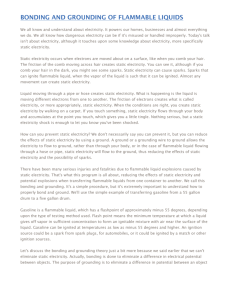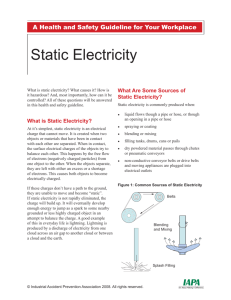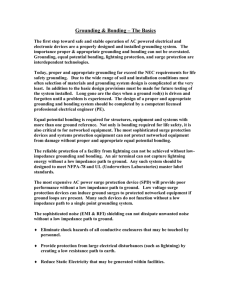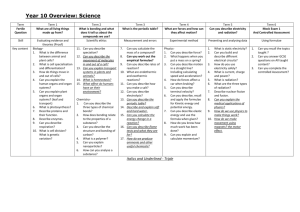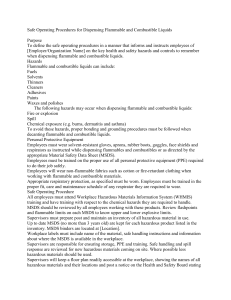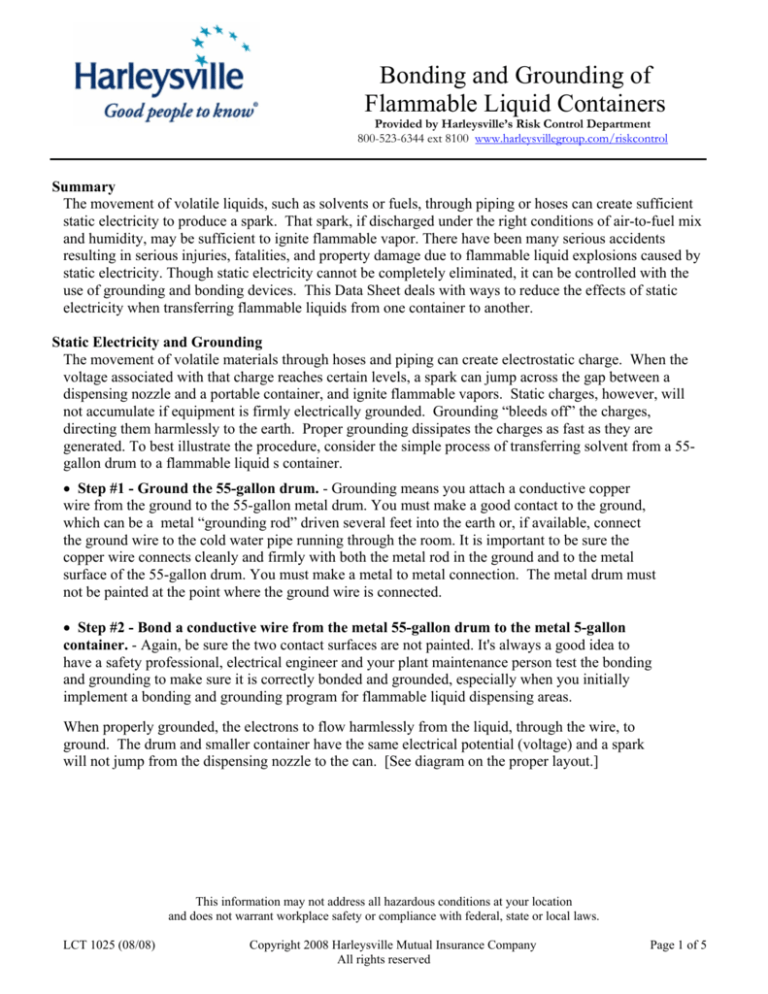
Bonding and Grounding of
Flammable Liquid Containers
Provided by Harleysville’s Risk Control Department
800-523-6344 ext 8100 www.harleysvillegroup.com/riskcontrol
Summary
The movement of volatile liquids, such as solvents or fuels, through piping or hoses can create sufficient
static electricity to produce a spark. That spark, if discharged under the right conditions of air-to-fuel mix
and humidity, may be sufficient to ignite flammable vapor. There have been many serious accidents
resulting in serious injuries, fatalities, and property damage due to flammable liquid explosions caused by
static electricity. Though static electricity cannot be completely eliminated, it can be controlled with the
use of grounding and bonding devices. This Data Sheet deals with ways to reduce the effects of static
electricity when transferring flammable liquids from one container to another.
Static Electricity and Grounding
The movement of volatile materials through hoses and piping can create electrostatic charge. When the
voltage associated with that charge reaches certain levels, a spark can jump across the gap between a
dispensing nozzle and a portable container, and ignite flammable vapors. Static charges, however, will
not accumulate if equipment is firmly electrically grounded. Grounding “bleeds off” the charges,
directing them harmlessly to the earth. Proper grounding dissipates the charges as fast as they are
generated. To best illustrate the procedure, consider the simple process of transferring solvent from a 55gallon drum to a flammable liquid s container.
• Step #1 - Ground the 55-gallon drum. - Grounding means you attach a conductive copper
wire from the ground to the 55-gallon metal drum. You must make a good contact to the ground,
which can be a metal “grounding rod” driven several feet into the earth or, if available, connect
the ground wire to the cold water pipe running through the room. It is important to be sure the
copper wire connects cleanly and firmly with both the metal rod in the ground and to the metal
surface of the 55-gallon drum. You must make a metal to metal connection. The metal drum must
not be painted at the point where the ground wire is connected.
• Step #2 - Bond a conductive wire from the metal 55-gallon drum to the metal 5-gallon
container. - Again, be sure the two contact surfaces are not painted. It's always a good idea to
have a safety professional, electrical engineer and your plant maintenance person test the bonding
and grounding to make sure it is correctly bonded and grounded, especially when you initially
implement a bonding and grounding program for flammable liquid dispensing areas.
When properly grounded, the electrons to flow harmlessly from the liquid, through the wire, to
ground. The drum and smaller container have the same electrical potential (voltage) and a spark
will not jump from the dispensing nozzle to the can. [See diagram on the proper layout.]
This information may not address all hazardous conditions at your location
and does not warrant workplace safety or compliance with federal, state or local laws.
LCT 1025 (08/08)
Copyright 2008 Harleysville Mutual Insurance Company
All rights reserved
Page 1 of 5
Other Sources of Static Electricity
Flammable liquid flowing through pipes and hoses are not the only causes of static electricity.
Anything that can frictionally move electrons can generate static electricity. Things like steam
lines, V belts, agitators, conveyor belts and so on can create a static charge. In environments where
they share space with flammable vapors, these too will need to be grounded.
Make sure all transfer hoses and nozzles are clean, rust, dirt or other non-conductors in the flow
can create electron flow and generate static electricity. Always inspect your bonding and ground
wire for broken or separated conductors.
Note: Static charges can even be generated by fan blades turning in the air. Helicopter blades can
actually generate enough static charge to stun a man. Industrial fans can also build up a substantial
charge.
Bonding and grounding systems should be checked regularly for electrical continuity. Many
organizations recommend the use of bare-braided flexible copper wire because it facilitates
inspection and prevents broken wires from being concealed.
If flammable liquids are transferred using an electric pump, the pump must be UL listed and made
for division 1, class 1 operation with explosion proof wiring.
Another source for generating static electricity is when liquids are transferred between portable
containers. When pouring liquids, the spout of the supply container should be in constant contact with the
lip of the container being filled. If it is not possible to bond and ground the containers using a permanent
system, the container being filled should be placed on a concrete or earthen floor, or grounded by other
means to reduce the electrical potential.
This information may not address all hazardous conditions at your location
and does not warrant workplace safety or compliance with federal, state or local laws.
LCT 1025 (08/08)
Copyright 2008 Harleysville Mutual Insurance Company
All rights reserved
Page 2 of 5
Additional Dispensing Hazards
• Splashing -As liquids are withdrawn from drums, provisions must be provided to permit air into
the drum or a vacuum will form inside. This is what produces a turbulent, splashing flow when
dispensing liquids. Turbulence generated in the drum creates its own source of static electricity.
• Internal Pressure – In summer and in warm environments, liquids expand as room temperature
increases. This can create high internal pressures in tightly sealed drums. Some method of
pressure relief is needed to prevent leakage at the bungs and weak drum joints. Also, when liquids
are put into a vessel, displaced air inside must be allowed to escape. Pressure relief valves are
installed on drums when the temperature rises to keep the pressure from building and possibly
bursting the container.
All drums must have UL listed accepted pressure relief valves (spring loaded) bungs to prevent the
drum from over-pressurization or vacuum situations.
Don't take chances! Use bonding and grounding for your protection as well as the protection of
others and of course, the assets of the organization.
This information may not address all hazardous conditions at your location
and does not warrant workplace safety or compliance with federal, state or local laws.
LCT 1025 (08/08)
Copyright 2008 Harleysville Mutual Insurance Company
All rights reserved
Page 3 of 5
For inspection purposes, the following is a sample checklist that can be modified to fit your needs:
Department:
Bonding cables:
• in good condition
• good contact points
Bonding clamps:
• in good condition
• good metal connection
Grounding conductors:
• in good condition
• lead to earth
Static electricity ground:
• direct to good earth
The following are free of static
grounds:
• electrical conduit systems
• plastic pipes
• gas or steam pipes
• dry pipe sprinkler systems
• lightning rods
Continuity checked
Conductivity measured
Safety cans:
• bonded and grounded
Yes
No
Initials of person doing inspection:______________
inspection:_______________
Recommended Action
Date of
This information may not address all hazardous conditions at your location
and does not warrant workplace safety or compliance with federal, state or local laws.
LCT 1025 (08/08)
Copyright 2008 Harleysville Mutual Insurance Company
All rights reserved
Page 4 of 5
Related Information:
The Protectoseal Company
225 W. Foster Ave.
Bensenville, IL 60106
Phone: (630) 595-0800
Lind Equipment Ltd.
Meyer Material Handling Products, Inc.
3904 S Arlington Ave
Indianapolis, IN 46203-6170
(317) 786-9214
NASD Video Database
Harleysville Insurance Co
Risk Control Data Sheet LC-P3
References
National Fire Protection Association, 1 Batterymarch Park, P.O. Box 9101, Quincy, MA 02269-9101.
NFPA 30, Flammable and Combustible Liquids Code, 2000 edition.
NFPA 69, Standard on Explosion Prevention Systems, 1997 edition.
NFPA 70, National Electrical Code®, 1999 edition.
The information and suggestions contained in this data sheet have been developed from sources believed
to be reliable. However, we accept no legal responsibility for the correctness or completeness of this
material or its application to specific factual situations.
This information may not address all hazardous conditions at your location
and does not warrant workplace safety or compliance with federal, state or local laws.
LCT 1025 (08/08)
Copyright 2008 Harleysville Mutual Insurance Company
All rights reserved
Page 5 of 5


